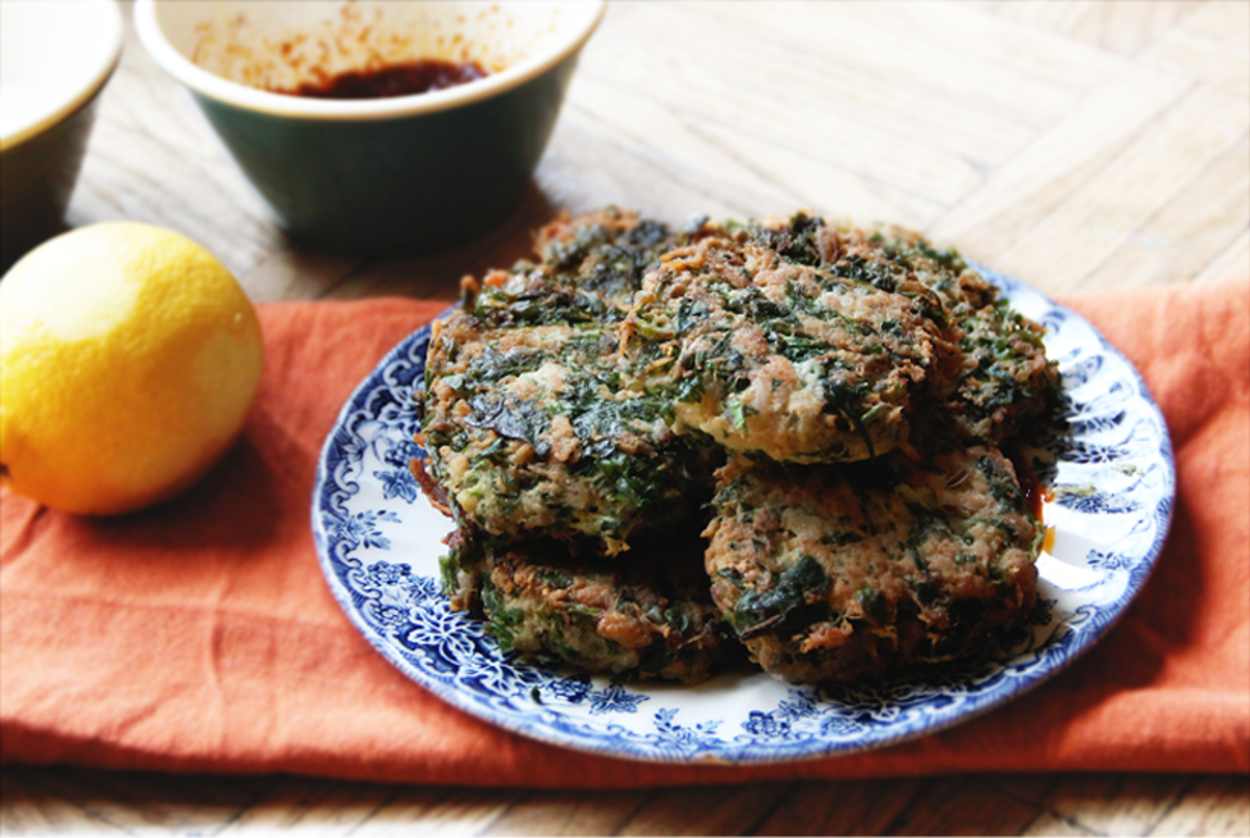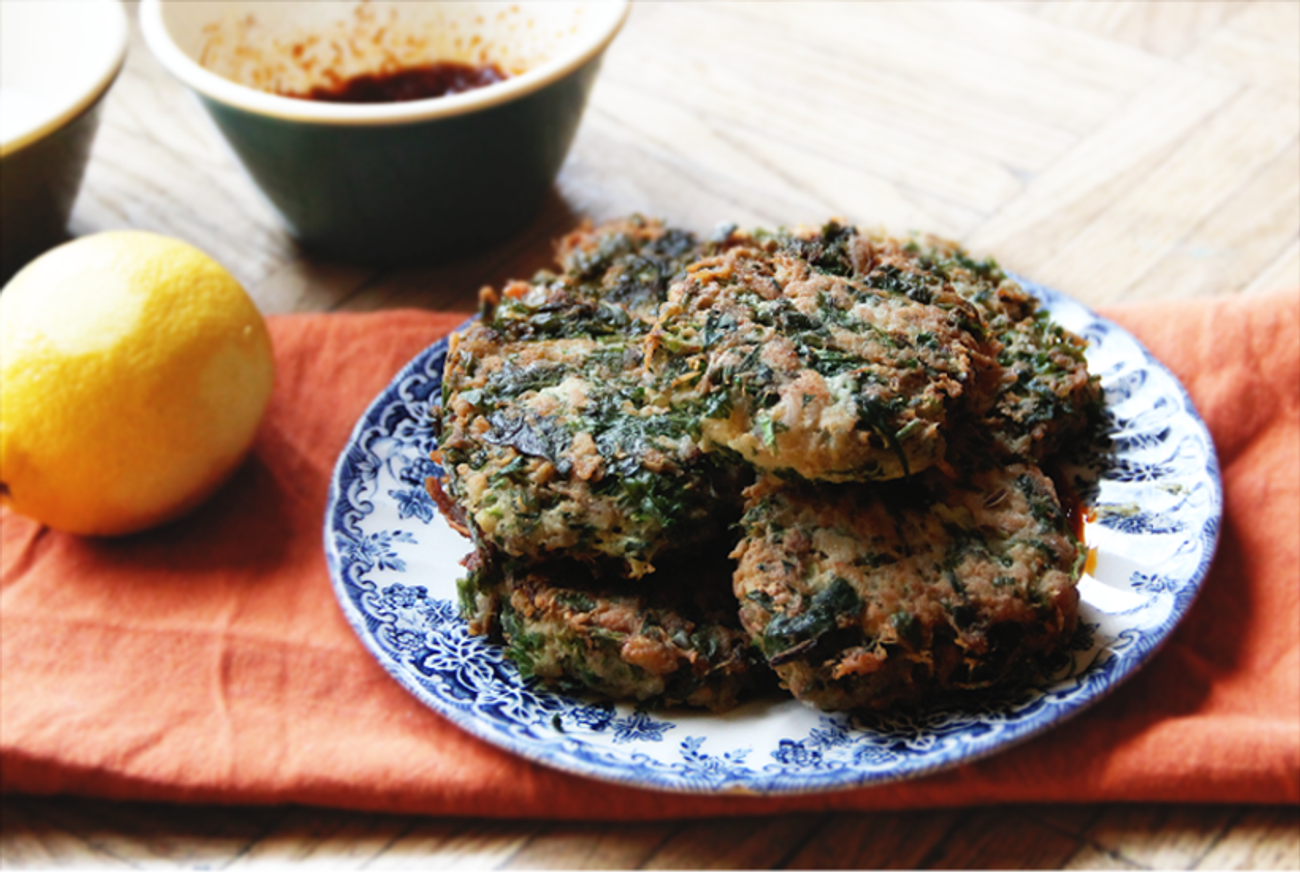A Moroccan Feast for Hanukkah: Hold the Latkes
From chicken fritters to honey-drizzled fried dough, a Moroccan menu gives the holiday a unique flavor




A few weeks ago, I had the good fortune of attending an early holiday party at my friends Ron and Leetal Arazi’s Brooklyn home. The Arazis, Israeli natives who run the artisanal Middle Eastern food company NY Shuk, were prepping dishes for a Hanukkah photo shoot and invited friends over to enjoy the feast.
Ron’s cooking is largely inspired by his family’s Moroccan heritage, so I arrived to find the table filled with orange-and-olive salad, couscous with roasted cauliflower, spicy matbucha, and other North African dishes glowing under the light of a menorah. The standout dish, however, was a platter of chicken levivot (recipe here), chicken-and-herb fritters that Ron’s mother made each year for Hanukkah when he was growing up.
“These were something my mom created to use up leftover chicken scraps,” Ron said. “I don’t think they are known outside of our household, but for us they became a tradition.” And for good reason. The chicken is simmered with spices—cinnamon, fennel seeds, dried sage, bay leaves, allspice—then finely shredded, mixed with fresh cilantro and parsley, mashed potato, and eggs, formed into patties and fried. The resulting herb-y, meaty fritters come served with harissa dipping sauce and are distressingly addictive.
Shortly after everyone had proclaimed themselves unable to eat another bite, Ron pulled out an oversized bowl filled with a bulging, burping mound of dough. “For sfenj—Moroccan Hanukkah doughnuts,” he explained. Working quickly, he pinched off small palmfuls of dough, punctured a hole in the center and, with small, sure movements, stretched them into elongated rings and slipped them into a pan of bubbling oil. They emerged shortly after, golden and spitting as they drained. Ignoring my full stomach, I took one straight from the platter and drizzled it with honey. Leetal had assured me that I had never had a doughnut quite like sfenj, and they did not disappoint. “They are probably Ron’s favorite thing in the entire world,” Leetal joked. I could understand why.
In Israel, the tradition of eating fried foods on Hanukkah (to commemorate the miracle of the oil in the Hanukkah story) has come to mean doughnuts above all else—particularly sufganiyot. There, the jelly-filled doughnuts trump the potato latkes favored by American Jews and spill out of every bakery window in the weeks leading up to the holiday. But for Moroccan Jews, sfenj are the Hanukkah doughnut of choice.
Coming from the Arabic word meaning “sponge,” sfenj resemble other ring-shaped doughnuts, but with a more rustic, freeform shape. Their texture is also noticeably different—an almost brittle, crispy outside countered by an airy texture within. Instead of being frosted or filled with jam, they are served with sugar, honey, or simple syrup for dipping and drizzling. (Ron and Leetal sometimes flavor their syrup with saffron and cardamom.)
Sfenj are popular throughout Morocco. “If you are a Moroccan Muslim, you will typically eat them year round for breakfast, without the sugar,” Ron told me. (If fried dough sounds a bit decadent for breakfast, compare it to the croissants and muffins Americans deem proper to eat before noon.) “In Morocco, sfenj are also a common street food,” Leetal added. In The Encyclopedia of Jewish Food, Gil Marks—who died last week—wrote: “In the souks (marketplaces) of Morocco, professional sfenj makers in tiny stalls customarily string up the fried rings on palm fronds.”
For Moroccan Jews, however, they are primarily Hanukkah fare. In Israel, sfenj are rarely, if ever, found next to sufganiyot in bakeries. “The flavor and texture don’t last long, so you want to eat them within a half an hour of frying,” explained Liora Kushner, a Moroccan Israeli who now runs a catering company out of Brookline, Mass. But they are commonly made at home during the eight nights of the holiday.
The party at the Arazis’ home mirrored the family Hanukkah gatherings Ron grew up celebrating with his Moroccan family in Israel. “Hanukkah was never a sit-down holiday like Rosh Hashanah, it was more freestyle,” he said. “My grandmother would pull out salads and spreads or some sweets to accompany the fried foods. It all depended on who came and who was hungry.”
In addition to the sfenj and the chicken fritters, for Hanukkah Ron’s grandmother often made popletas—fried, meat-filled potato dumplings more commonly known as pastelim. (“Popletas is possibly a family or regional nickname,” Leetal said.) In The Encyclopedia of Jewish Food, Marks wrote that on Hanukkah many Moroccan families also eat zangula, “deep-fried batter poured into hot oil in a thin spiral, similar to Amish funnel cakes.” In Kushner’s family, makroud—diamond-shaped cookies that are fried and dipped in sugar—were common. “We have a big extended family and would go from one home to another to light candles each night,” she said. “There was tons of food every night—you felt like you had to go on a cleanse after the holiday!”
Today, Israel is home to nearly 1 million Jews from Morocco, more than any other country. And it is within these communities—like the ones Kushner and Arazi grew up in—that Moroccan Hanukkah traditions still thrive. “In Israel, you still have many first-generation immigrants making these foods,” said Janna Gur, a cookbook author and editor of the popular Israeli food magazine Al Hashulchan. “It is like a living museum.”
Meanwhile, she said, many families come from blended backgrounds and include food traditions from several different cultures—Turkish, Moroccan, and Polish, say, or Yemenite and Russian—in one kitchen. “My kitchen is more Israeli Moroccan than pure Moroccan,” Kushner said. Like Ron’s mother’s chicken fritters, Kushner said she now makes “lots of different latkes for Hanukkah that include things like feta, spices, and fresh herbs. They aren’t strictly family recipes, but they are inspired by those flavors.”
For people like Kushner and the Arazis, who live far from their Moroccan families in Israel, Hanukkah offers an opportunity to connect and inspire others. The Arazis regularly host dinners and cooking events as a way of introducing customers and friends to lesser-known Middle Eastern and North African dishes—like sfenj, popletas, and the chicken levivot. Meanwhile, Kushner said, “I started Liora’s Catering because I missed the tastes of home.” This year, she will cater several Hanukkah events in the Boston area and include several Moroccan-influenced recipes on her menus. If clients ask, she said she will even make sfenj, which she personally fries to order at the event so they can be eaten fresh.
“You have to have the right kitchen that can accommodate it and be OK with the smell of oil in your house after,” said Kushner. But if all the stars align, she said, “there’s nothing better than fresh doughnuts on Hanukkah!”